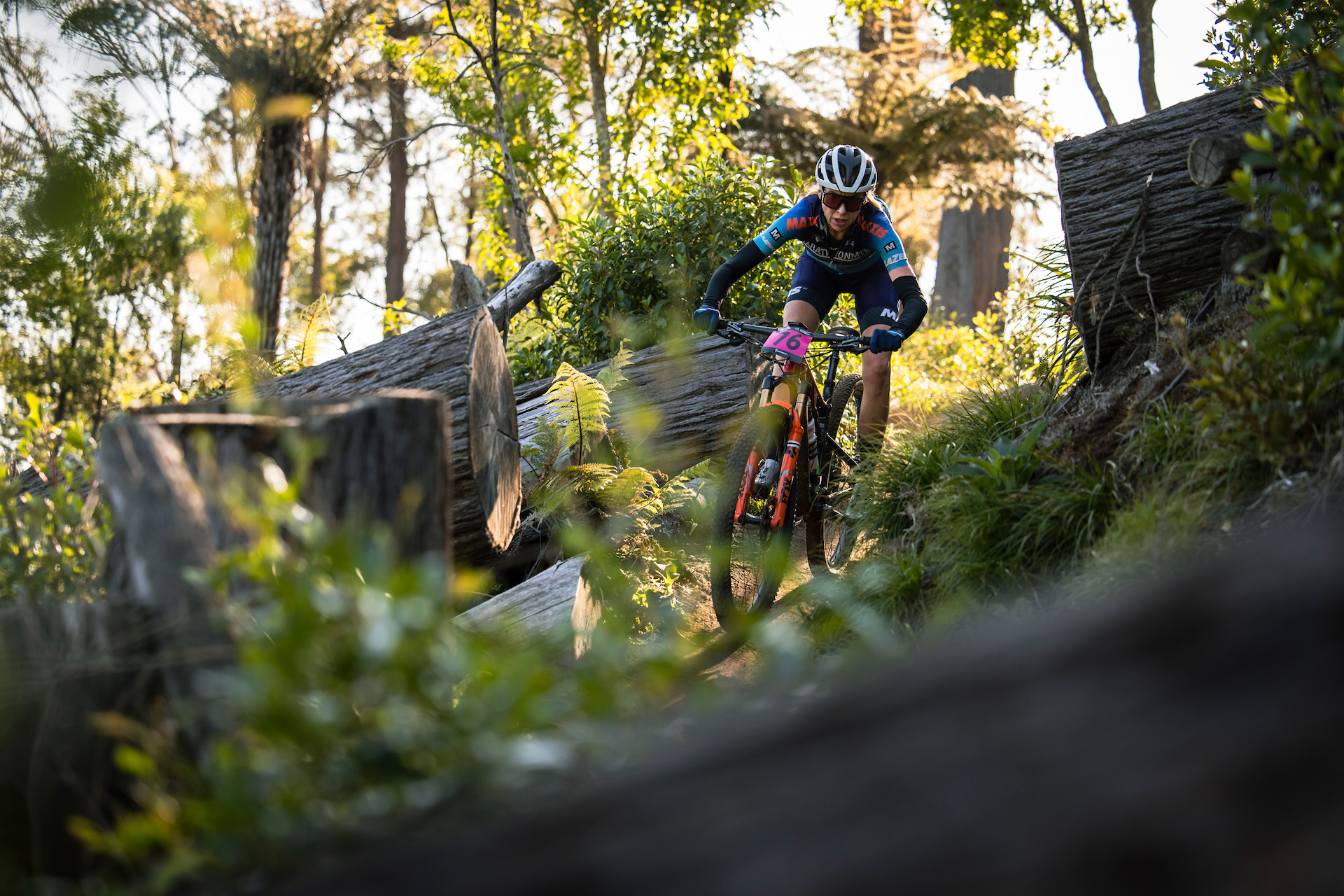Luke Beuchat is an Escape Collective member and the creator/developer behind the Escape Collective Fantasy Competition and app. He’s also a gun mountain biker. We asked him to share his experience from the Whaka 100 MTB Marathon, held last week in Rotorua, New Zealand.
If you’ve ever had a chat with a mate about a marathon mountain bike race or overheard a conversation relating to one, invariably the first question is: “How much singletrack?”. In mountain bike parlance the amount and quality of singletrack is inextricably linked to the stoke factor of the experience. This formula applies equally to a fun day on trails as much as it does to a race day.
Based on my recent experience at New Zealand’s Whaka 100, one of the most iconic marathon mountain bike races in the Southern Hemisphere, the formula was executed to perfection. This is not what I expected.
The status of a mountain bike race is heavily influenced by the singletrack-to-fire road ratio. When a race is described using the phrase “good for roadies” it generally means: a ton more fire road than singletrack, monster climbs on smooth gravel, and not a lot of technical off-road riding. With a quoted 88% singletrack, the Whaka 100 certainly does not attract such a description. I can confidently say, after first-hand experience, the 88% did not come from the marketing department!
The technical aspects of general trail riding have evolved rapidly over the past five years. And a whole new bike category has been created – so-called down-country bikes. These bikes are incredibly capable descenders yet still have top-level pedaling efficiency for going up. And most importantly, even with dual suspension and dropper posts they remain incredibly light (sub 11 kg).
The evolution of these bikes has meant mountain bike races have either had to evolve to meet the demands of the market, or simply disappear. The latter has happened to a lot of marathon mountain bikes across Australia and New Zealand. Races with names like “Highland Fling”, “Angry Doctor”, and “Husky 100” have all disappeared as their technical trail composition was far too small and they failed to evolve to meet the market. A large proportion of riders who love to mountain bike and love to race no longer want to do races that favour the “roadie”. The Whaka 100 is not such a race.
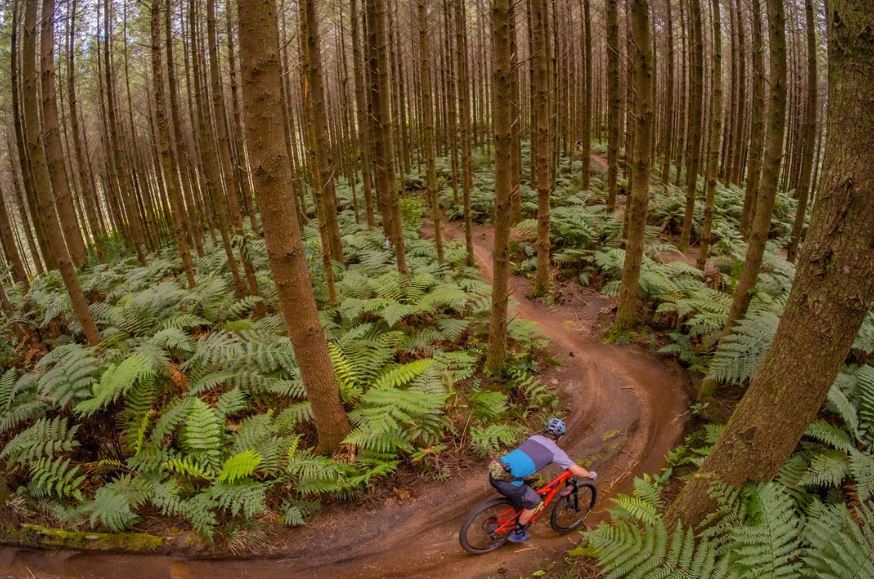
The Whaka 100 was first raced in 2007 when its organisers, Dean Watson and Marcus Diprose, set themselves a goal of finding a route through the Whakarewarewa trails, near Rotorua, without using the same piece of singletrack. Now, over 15 years on, the Whaka 100 continues to evolve and change with an ever-expanding trail network. And it is for this reason that the Whaka 100 now has the reputation of being one of the most unique and toughest single-day MTB marathon races in the Southern Hemisphere.
The Whaka 100 was a race that was well ahead of its time and now is in its prime. The design aspects of mountain bikes and the standard of riders is now at a level that matches the quantity and quality of the singletrack in the Whaka 100.
Rotorua – one of the first true mountain bike destinations
Rotorua is a large town about two and half hours south of NZ’s largest city, Auckland. The first trails were built in Rotorua exactly 25 years ago when local New Zealander, Fred Chritensen, took one of the first generation of mountain bikes into the Whakarewarewa Forest and was blown away by the perfect combination of soil, clay, and pumice. Almost immediately he packed his bags and kicked off trailbuilding in Rotorua.
Within years Rotorua grew to become a world-class destination for singletrack mountain biking. It has hosted the UCI Mountain Bike World Championships (2006) and also the freeride festival known as Crankworx (2015). As such there are not many MTBers who would not have Rotorua on their bucket list of destinations.
The Whaka 100 Experience
Earlier in 2023 I was having a WhatsApp chat with two good mates – Minter Barnard and Todd Sinclair – about potential races for the year. Both had been teammates of mine at Cape Epic – Todd in 2015 and Minter in 2019. And we had all just turned 50 – not only is that a significant milestone but it means you become the youngest in your race age category (50 – 59). As some of you may know well, in both road and MTB, as you move up through the age categories, the field size gets smaller and becomes more fiercely competitive. Far too many middle-aged men with too much time on their hands and who are no longer playing golf!
Todd had moved to New Zealand three years ago and did the Whaka 100 last year. He couldn’t stop raving about it. And of course, both Minter and I, who identify as mountain bikers, knew only too well the quality of the Rotorua trails. Further, as mentioned, there is no longer a lot of choice when it comes to marathon mountain bike races! So, the date was set – October 22, 2023 – Rotorua, New Zealand for the Whaka 100. All 107 km of it with 3,000 metres of vertical, most of it on purpose-built singletrack including some seriously technical trails.
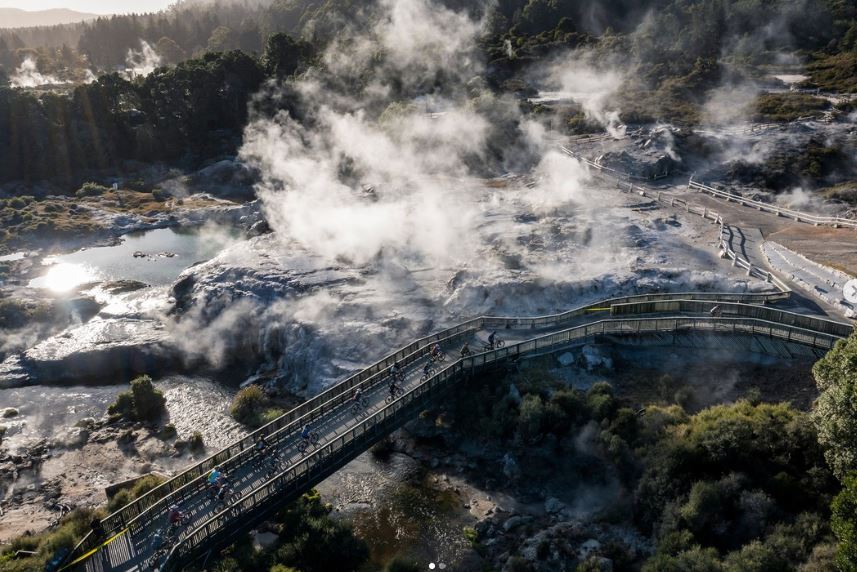
Here’s how I would describe each of our backgrounds and training regimes in the lead up to the Whaka 100:
Todd, the roadie without a dropper – He won’t forgive me for this description but until recently he was racing on the road in Singapore because there isn’t much in the way of mountain biking. And since we did the Cape Epic together eight years ago he has been on about as many MTB rides as the number of times I’ve had Marmite on my toast (this is a unique New Zealand yeast-based spread). Todd’s preparation for the Whaka 100 was a ton of road riding with a crew around Auckland. Hence I think the label is appropriate.
Minter, the consummate MTB racer – His recent palmares illustrates why he is known within our bike group as “the King” – two-time XCO Masters national champ, two-time XCM masters national Champ, fourth in the UCI World MTB Masters 2023, and a string of 100 km wins over the past five years in Australia. If any Bright locals are reading this then they will validate the fact that he knows how to go down a trail pretty much as fast as he can go up it. The down-country evolution of bikes has worked well for him! Minter’s prep for the Whaka 100 was right on par – no better way to train for a race than to do MTB races!
Me, with a foot in each camp – I’ve raced road and MTB. But if I was asked the question, what do I identify as, I’d have no hesitation in answering: MTBer. I’ve done quite a few mountain bike races in different parts of the world – Cape Epic twice in South Africa, Trans Alps in Europe, BC Bike Race in Canada, numerous four-day stage races in Australia, and all the main 100 km mountain bike races in Australia. Given I knew on paper what was coming in the Whaka 100 I tried to ride my MTB as much as possible on the trails around my hometown of Sydney. Luckily Sydney is blessed with an incredible network of trails.
Looking at the profile and make-up of the Whaka 100 it is not the 3,000 vertical metres of climbing that looks the most daunting – it’s the 85%+ of singletrack looks like the killer. With a bit of primary school mathematics that’s 91 km of pure unadulterated trail riding. If you weren’t racing that would sound like heaven. But more singletrack means more time in the saddle and a much, much longer day.
Typically, in a 100 km race you look forward to ticking off 40 km on fire trail. More singletrack means your duration of concentration increases considerably and your core muscles and hands never get a break. This really concerned me, especially as it is hard to put in regular six-hour training rides. So a strange question formed in my head – did the Whaka 100 have too much singletrack packed in? Had it gone too far the other way? And this weighed quite significantly on my pre-race nerves in the lead-up. But it would prove to be wasted nervous energy.
In the race chute
So there we were, 7:50am on the start line of the Whaka 100, about to be sent off into the Whakarewarewa Forest and the expansive rabbit warren of trails. Unlike most marathon races which generally start with some sort of fire road climb to try to sort the field out, the Whaka 100 jumps instantly into the loamy singletrack. Typically, this can cause lots of stress and dodgy passing moves in the field. However, the selection of the starting singletrack – Tahi, Creek Track, and Grinder – was absolutely perfect. It was a relatively flat, flowy and grippy piece of trail. This meant that any competent rider could easily negotiate it at pace. This trail went on for about 4 km and due to this the field slowly spread out naturally. Far better than the typical high-stress, high pace of most marathon race starts.
From here until the first real technical trail it was a series of flowy singletrack punctuated with short fire roads. The fire roads never dragged and provided you with just enough time to grab a drink and rest your hands. Trails with names like Arepa, Turkish Delight – just seemed to come and go quickly. The kilometres ticked away effortlessly, although matches were of course being burnt.
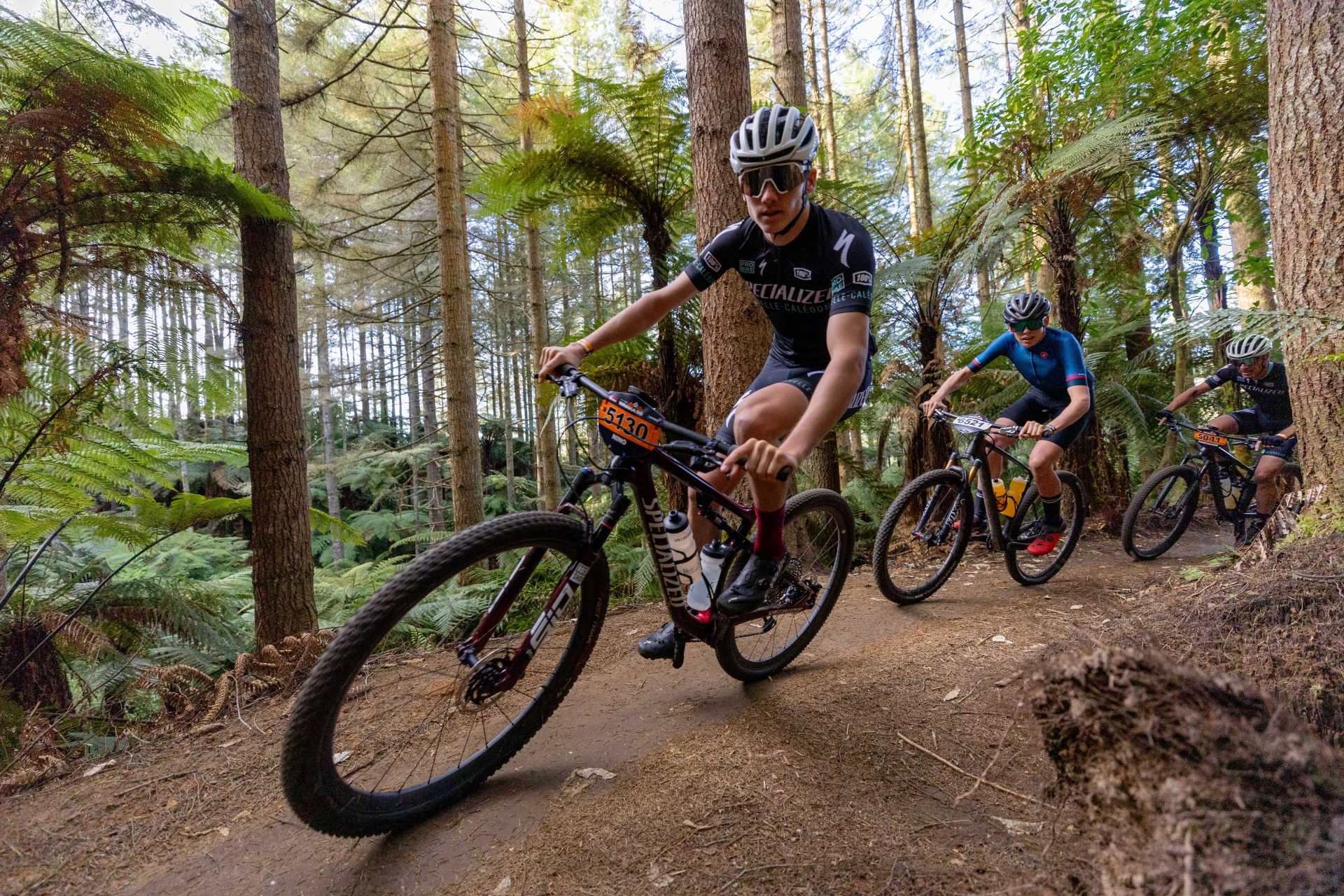
The first piece of technical trail came at about 25 km and is known as “Box of Birds”. This trail has an A and B line pretty much for the whole trail! This is down trail and riding the B-line fast still takes two minutes more than the A line. This was my first mistake – I followed another rider into the B line and was too far down before I realized. I immediately lost two minutes to Minter due to the wrong trail choice. And Todd lost about four minutes due to his roadie status! So just 25 kilometres in it was abundantly clear that it pays to be technically competent in this bike race.
The real meat of the Whaka 100
At 40 km you hit a trail called Hot X Buns – this is a renowned piece of track for the Rotorua trails. It is a fast-flowing, narrow piece of loam singletrack. The challenging part about it is the rooty drops that sporadically appear as you hurtle down it. I had an over-the-bars (OTB) incident going down this as I was too hot coming out of drop into a right-hander and locked up trying to avoid a tree. Luckily my bike and I ended up on a soft bed of ferns. A quick once-over of myself and my bike and I was on my way again … although I made a mental note to wind it back 10% on the tech trails of the Whaka 100.
On Hot X Buns I lost a minute to Minter and Todd lost three minutes. I think you are starting to get the picture.
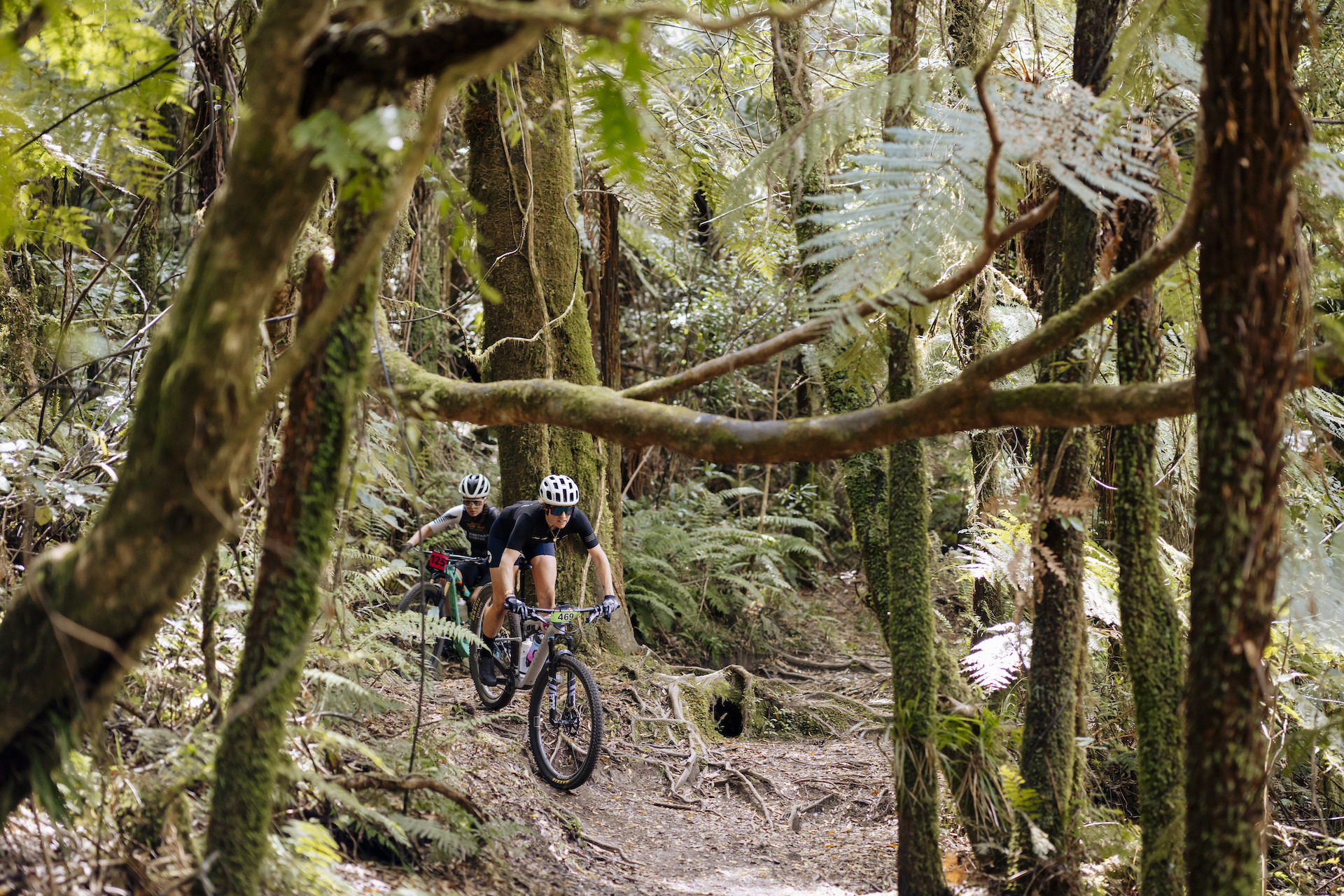
From here it was on to the first monster climb of the Whaka 100: 400 metres of vertical. Strangely though it did not feel like a monster climb as it was a combination of fire road, doubletrack, and singletrack. The surface and forest changed continually as we climbed through the several elevations of the Whakarewarewa Forest and this made the climb feel far less daunting.
At the top of this climb you hit a piece of rooty downhill singletrack called Tihi O Tawa. It is a super fun piece of track but has so many locations where it is easy to come unstuck. Time losses here were: Todd four and half minutes to Minter, and myself two and half minutes. Again, on a downhill!
Through the middle of the race we hit a series of trails that go around Lake Rotokakahi. One particular trail stood out – Kung Fu Walrus. Around 8% down, tacky clay, and perfect natural berms – I mean for the 60 km point does it get any better? This deposited us on to the shores of one of the bluest lakes I’ve seen.
With most 100 km races the last 15 to 20 km are the point where you really begin to grovel. The Whaka 100 is a little different. First, after a chunky 400 metre vertical climb you are seriously rewarded with a trail called “Split Enz” – 4 km of fast, flowy and bermed singletrack – it really never seems to end. Truly incredible. You are then dumped on to a trail called “Old Chevy”, in the heart of a cool, fern forest. This kicks off a whole host of trails – “Lion”, “Rock Drop”, “Rosebank” – which are all twisty, tacky pieces of singletrack that guide you to the icon creek crossing that marks 200 metres from the finish of the Whaka 100.
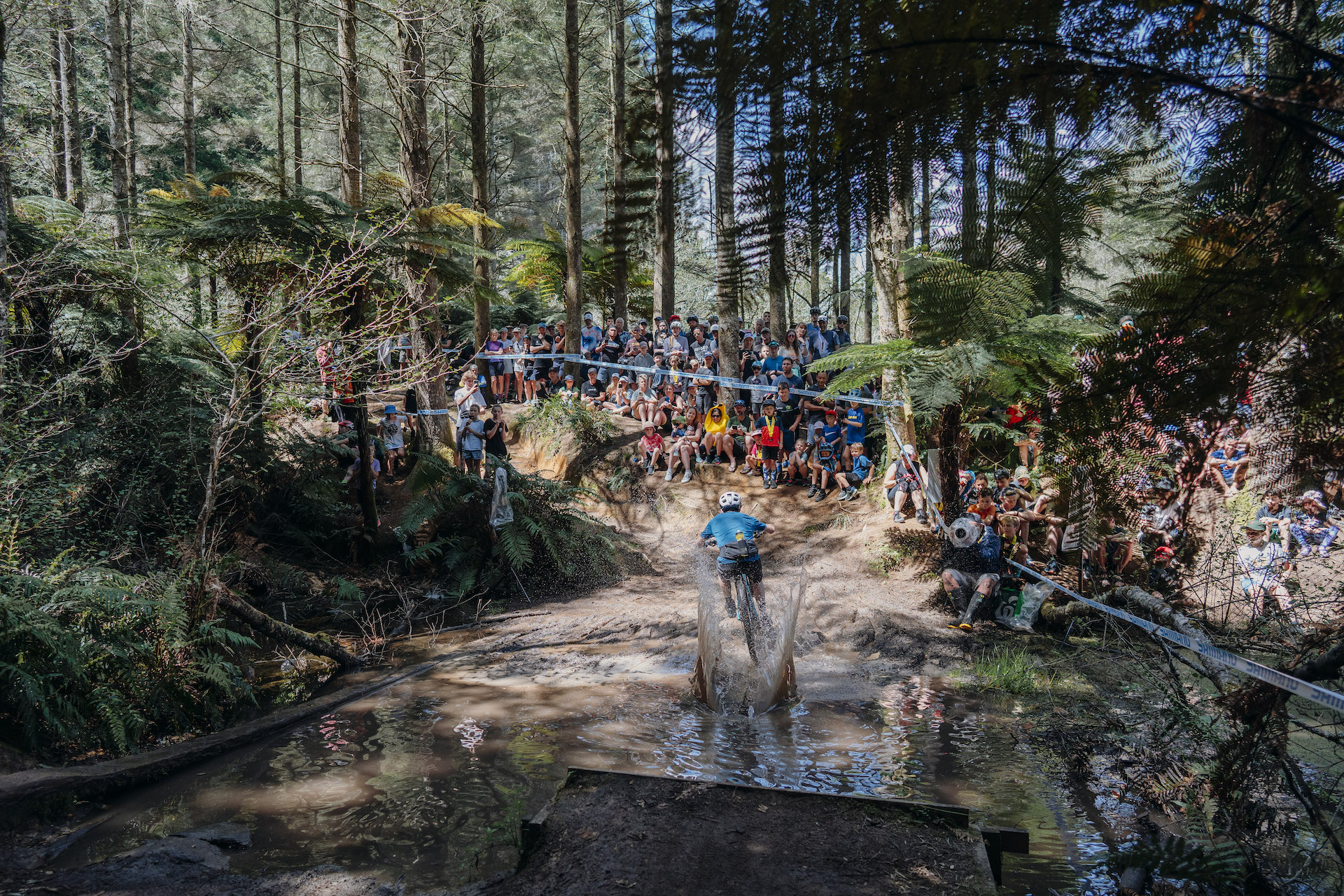
It is not often you finish a 100 km MTB race and think “How good was that?!” More often than not you are just too mentally and physically broken to contemplate that thought. As you labour the pedals across the finish mat the elation comes from the very simple thought – you no longer need to turn the pedals and that you are still in one piece.
I have done a lot of marathon MTB races in my time and I can categorically say I have never ever had that feeling – “How good was that?!” – at the end of a race, let alone mid-race. But as I railed through another pristine berm of “Kung Fu Walrus” that circumnavigated the pristine blue waters of Lake Rotokakahi that thought spontaneously entered by head.
Maybe it was the endorphins running through my body or maybe it was the coffee-infused gel I had just popped. Nevertheless, I knew two things as I crossed the Whaka 100 finish line: for sure I am coming back and secondly, mountain bike evolution and trail evolution have certainly reached a pretty darn good pinnacle!
MTB equilibrium and take that roadies!
Twenty-five years of trails, 16 years of race history, and now riders, bike technology and the trails of Whaka 100 are aligned. If you have a modern mountain bike (read 29er wheels, dropper, and slack-ish head angle) and some decent skills, it would be impossible to do this race and not finish with an immense sense of satisfaction and enjoyment. Not to mention quite a few PRs on Strava.
Not surprisingly within our little group the placings were as I had forecast: the consummate MTBer (Minter, first in 50-59) followed by the bike rider with foot in each camp (me, third in 50-59), and then the roadie without a dropper (Todd, fifth in 50-59). The placings bely the time differences though and the majority of the times losses occurred on the descents. This sample size obviously provides hard evidence that you cannot win this thing by being a fit roadie.
Whether you identify as a mountain biker, a roadie, or a bike rider with a foot in each camp, this race will truly redefine your perception of a marathon race. Actually, it will redefine your perception of a race … period. This truly is one of the world’s iconic singletrack races.
Follow the link for results from the 2023 Whaka 100 MTB Marathon.
Rotorua – The lowdown
How to get there
Rotorua is located an easy 2 hour 45 minute drive from Auckland International Airport. It is a large town by New Zealand standards and has a large range of accommodation options. The town is pancake flat and grid-style so it’s extremely easy to navigate. First port of call for more info is the town’s official tourism website.
The trails
The Rotorua Mountain Bike Trail Head is located a flat 4 km from the center of Rotorua, on Waipa State Mill Rd. From here there is access to over 160 km of trails covering all levels of difficulty. If gravity is more your thing, shuttles operate regularly. Rotorua has not rested on its laurels – it has continually evolved to meet the greater focus on gravity in the MTB market. There are some serious flow trails here with some serious hits. Even though there are now a lot more destination MTB parks in the Southern Hemisphere Rotorua still remains a world-class mountain bike destination.
That smell and geothermals
Rotorua sits within the Pacific Rim of Fire and as such is smack bang on top of one of the world’s most active geothermal fields. Wherever you go in Rotorua you will not be far from seeing steam coming off bubbling pools. For this reason, Rotorua offers a range of options for swimming or relaxing in the magnificent thermal waters. Warm up in a natural lakeside hot pool, stand under a hot waterfall, or float under the Milky Way in a hot stream.
The city also features a thermally heated public swimming pool, and several luxurious thermal spas. And in fact, the pools in most of the hotels are heated naturally from the geothermal activity!
Unfortunately, it is also world renowned for its smell. A byproduct of the geothermal activity is sulphur gas releases. To be honest though it was far less pungent than I had expected. And it is only noticeable when near geothermal pools. In most of the town and certainly on the mountain bike trails there is absolutely no smell whatsoever.
Other cool stuff in Rotorua
In true New Zealand style there is a ton of other adventure activities to do:
- Skyline Gondola and Luge – probably the best fun you can have off a mountain bike
- Redwood Forest Canopy Walk
- Zorba Ball – think giant plastic balls rolling down a hill.
- Jet boating, white water rafting, spas, and hot pools – see the Rotorua website for a comprehensive list.
What did you think of this story?
